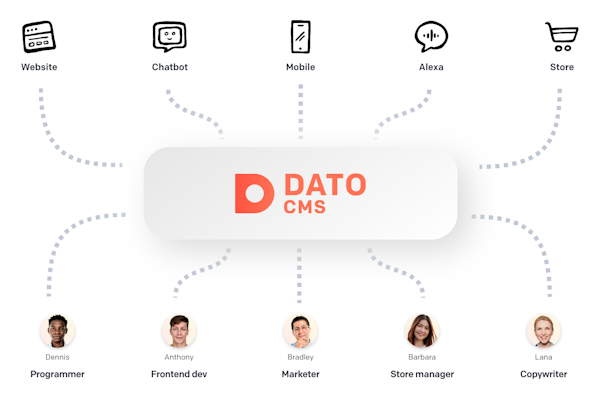Headless CMS vs Traditional CMS
Headless CMS vs Traditional CMS: Which Is the Best for You?
Traditional CMSs have historically represented one of the most adopted ways to manage content when having full control over the application development is a top priority. On the other hand, in recent years, several advanced CMS services accessible on the cloud have been developed and become increasingly popular. Such solutions are typically called “headless” and now represent a trend. This is where the Headless CMS vs Traditional CMS challenge begins. Let’s compare the two approaches to content management and finally provide you with the criteria to find the answer to this question based on your needs.
What is a traditional CMS?
A traditional CMS (Content Management System) is nothing but a CMS application built exclusively for a company or to meet specific use cases. Such solutions are tailored towards the needs of a particular business or even a single department, and help it create, update, manage, store, and publish digital content.
Typically, you can find traditional CMSs in use by eCommerce businesses. Since their online stores are what generates their revenue, they tend to prefer custom-made solutions to have complete control over their development, features, and future evolutions.
In this regard, a good traditional CMS includes all the features you would expect from a general CMS, but also all the customization in terms of functionality and usability. Such customizations are implemented with the specific needs of your business in mind by the company you commissioned the CMS or your IT department. In most cases, they are also expandable with custom tools, extensions, or plugins.
Traditional CMSs are also informally referred to as “homebrew CMSs”. This is because in some cases they are built by small teams or even a single person and are only intended for internal use. Generally, they start as a small, easy-to-manage project, and then grow large and complex, requiring more and more maintenance as well as advanced technical skills. But keep in mind that you do not have to code your traditional CMS yourself, as it is one of the most common services offered by IT companies.
Why and When to Use a traditional CMS?
There are 3 main reasons to adopt a traditional CMS. Let's have a look at all of them.
It meets your custom needs: if your business operates in a very particular industry and has unique requirements, then chances are that it needs to use custom-built software as well. In this case, you cannot but opt for a traditional CMS built to meet exclusively your needs.
It gives you full control: if your CMS represents a crucial element for your company, as in the case of eCommerce businesses, then you may want to have full control over it. Having a customized and efficient CMS can be a competitive advantage. As a result, you want control over its development, the release of new versions, and any other aspect.
You have access to the source code and data: if having access to the source code, databases, and files that make up your CMS is a priority, then you require a custom solution. This can be either an internally developed solution or an outsourced application released under custom agreements with the company that built it for you.
As a general rule, traditional CMSs are generally adopted when the budget is not a problem. In fact, maintaining and developing such software can be extremely expensive, especially in the long run. As reported here, some examples of popular companies using a traditional CMS are The New York Times, Hearst Newspapers, Cox Media Group, Vox Media, and BuzzFeed.
What is a Headless CMS?
Before delving into headless CMSs, it is crucial to understand the SaaS paradigm. SaaS stands for Software as a Service and represents a software licensing and delivery model in which a set of applications are accessible through the Internet on the cloud on a subscription basis. Consequently, a SaaS CMS is a centrally hosted CMS application that you can access through the web on any device and in any place.
In detail, the most common and popular implementation of the SaaS CMS concept is represented by headless CMSs. Specifically, a headless CMS is a back-end service that works mainly as content repository software. Thus, a headless CMS is an application developed by an external company that makes it available through a login portal, and that you can use to manage your content.
Notice how headless CMS solutions can benefit from being used by many people, companies, and departments with different needs. So, when someone requests a new feature, once it is developed, this will be accessible to everyone else.
Since it is a back-end-only application, a headless CMS generally provides a set of APIs to let you retrieve your content and expose it in your front-end application. As you can see, by adopting a headless CMS, you are totally decoupling your front-end from your back-end. So, you can even use a single headless CMS to manage the content for multiple websites.
As it should now be clear, such software is called “headless” because it comes with no “head”, which represents the front-end layer in this metaphor.
Why and When to Adopt a Headless CMS?
These are 3 main reasons why a SaaS headless CMS is a great solution. Let’s have a look at all of them.
It meets your generic specific needs: most businesses do not have custom or specific needs. It is likely that most of the online CMS solutions already available offer features and functionality that can help you manage your content in each aspect.
Is it always up-to-date: if using only cutting-edge technologies or applications that are continuously updated is crucial for you, then you should opt for a headless CMS. This is likely to meet the current standards when it comes to privacy, security, speed, and usability.
It saves you time and money: buying access to a service is less expensive and time-consuming than building it. If your budget is limited, you should consider pre-built solutions that can offer you most, if not all, the features you need.
If your company is small, new, and does not want to invest time, money, and resources in building a traditional CMS but focus more on the front-end, then you should embrace a headless CMS. In that case, as found out by this research, your website would become part of the millions of websites that are currently using a headless CMS solution. This means that headless CMSs are now widely popular and are likely to become increasingly used by businesses from all over the world.
Headless CMS vs Traditional CMS: Pros and Cons
Traditional CMS
Pros:
tailored to your needs
has only the features you really need
gives you with full control over its development
access to the source code, files, databases
Cons:
expensive to build it and maintain it up-to-date
challenging to keep it security compliant
time-consuming and expensive to maintain all the features in the long-term
only accessible on the company network or computers
Headless CMS
Pros:
accessible anywhere, anytime
always up-to-date
must be secure to be successful
must be usable for end-users and especially for marketers to be successful
focused on the content management, not on the frontend
affordable
comes with a large community of users
Cons:
does not provide you with full control
general-purpose features only
requires an Internet connection
What is the best CMS for you?
Unless you have real custom needs and a large budget, you should take into consideration a headless CMS. As shown above, traditional CMSs come with too many challenges that can easily turn your custom application into an overly complicated and expensive solution. Considering this, opting for an internal “homebrew” CMS is risky. Start managing with large and complex, CDN (Content Delivery Services) services, security issues, bugs, new features, and requests involving custom components arising every day, and you will easily end up with a headache.
On the other hand, even though a headless CMS application does not provide you with all the freedom coming with a traditional CMS, it will help you solve your major and most important content management requirements. Image a situation with no more self-managing, problems, and headaches, at a better price. This is what headless CMSs are about.
Now, you might be wondering which is the best headless CMS for you. After all, there are several options in the market, but DatoCMS is one of the top SaaS and headless CMSs currently available. It comes with dozens of features designed by a team of experts with content management in mind.
If you have an eCommerce business, and you are anchored to an old and risky traditional CMS, go headless and try out DatoCMS for free.
Conclusion
In this article we tried to compare a headless CMS vs traditional CMS approach, we looked at what a traditional CMS is, why you should adopt it, and in which cases it is generally adopted. Similarly, we learned what the headless CMS concept represents, understanding why headless CMSs are so widely used and may easily represent the future of content management applications. Finally, we compared traditional CMSs with headless CMSs and provide you with the criteria to help you choose the best solution for your needs.
Thanks for reading! We hope that you found this article helpful. Feel free to reach out to us on Twitter with any questions, comments, or suggestions.


